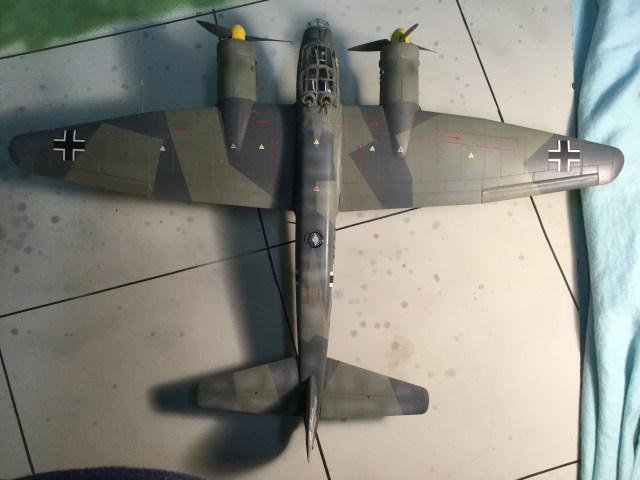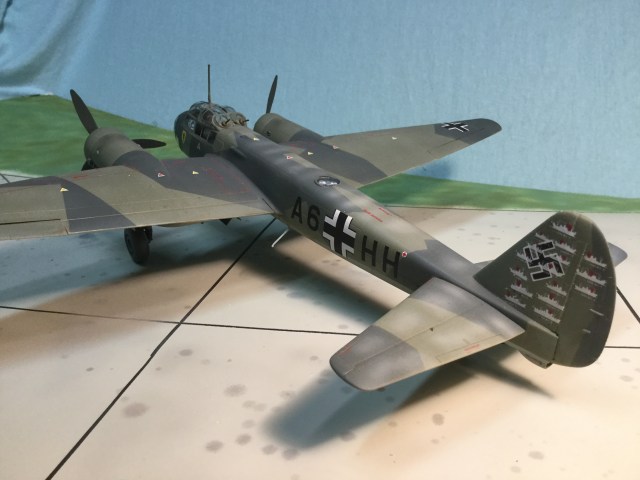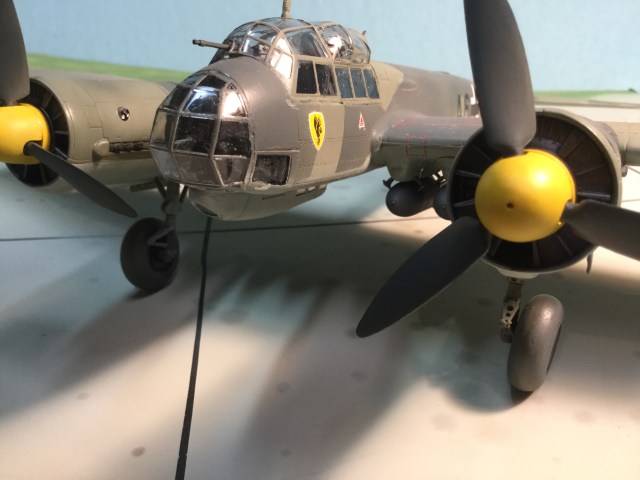This medium bomber was the most produced sort used by the Luftwaffe during the war.

After the jump, a brief look at this German work horse.
This type first flew in 1936 as a fast bomber. Initial development was lengthy and troublesome, especially after a “dive bombing” requirement was added. Only 12 aircraft were available on the first day of the war. But production rates soon improved and by early 1940 the type was in widespread service. True dive bombing was abandoned early on due to structural stress issues; but for shallow 45 degree dives and more conventional level bombing runs the type was very capable.

The Ju88 was eventually to be the most versatile German type; with bomber, night fighter, heavy fighter, recon and flying bomb versions all seeing service. Germany was the main user while Finland, Spain, Hungary, Romania and Italy also purchased the type.


This example is a plane flown by Werner Baumbach in early 1942 when he was with KG30. He was one of the most proficient anti-shipping experts of the war. In 1942 he was assigned to a new bomber development program and finished out the war in charge of the Luftwaffe bomber force.

Werner Baumbach’s success shown graphically on the tail.
This kit is from Revell’s Pro Modeler line and I used TechMod decals. This is one of the more interesting kits I’ve ever worked with. I believe it was first designed by Dragon as a Ju88 C/G (heavy Fighter/Night Fighter). Revell acquired the tooling (or co-developed with Dragon?) to do the bomber version. But there are so many differences there are a lot of new sprues. Particularly noticeable are the clear parts; there is exactly ONE part from the original tooling that gets used. Even better, we need TWO of it for this version. So, you guessed it, we get two complete clear part sprues in this boxing in addition to the new sprue with all the additional parts required. Also notice this plane has four external bomb racks under the wing. Well two of those racks are identical to those used on the Ju188, that Dragon had already tooled. So we also get two full sprues from the Ju188 for those two bomb racks, the other two were newly tooled. I’ve long heard that plastic itself is the single cheapest part of issuing a new model kit, this one seems to put an exclamation point on it!
Building itself was a learning experience for me. This is maybe not a true “limited run” kit, but its close to it and is by far the biggest project of this sort I’ve ever done. I’m not quite satisfied with the results, I see a few glaring errors I’d like to fix, and might someday. But for now I’m ready to call it “done”. I’ll likely fess up to anything you want to call me on.
The TechMod decals were mostly excellent and very thin. The only glitch being that they are so thin a couple of the larger decals tore and were otherwise hard to work with. But I will happily use this brand again.

A Ju88A of KG51 flying over the Eastern Front. (from asisbiz.com)



The only Ju 88 I built was in the 60s. 1/72 Lindbergh kit.
Make that Lindberg…
Oh that’s a classic! I built one when I was a kid.
I still remember it. I can see it in my mind.
The Ju88 was certainly a versatile aircraft and your model is a superb example of it.
Thanks AT. It sure fills a big void in my collection.
Love it Dave.
The night-fighter version was deadly for RAF and RCAF bombers.
Yeah it was a very dangerous aircraft. Very similar to the Mosquito; well, a little older but similar idea.
It looks great to me Dave. I love the JU-88, an extremely versatile aircraft – I made a Finnish version a couple of years back and really enjoyed it.
Eventually I hope to do one in Romanian markings, or maybe American. Its the same plane either way, it was captured by the British and eventually wound up at the US Air Force Museum in Dayton.
No doubt this plane got around!
nice result! ..building the Zvezda 88 G-6 currently
Thank you!
I believe the Zvesda kit is 1/72? How’s it coming?
Here Dave…
That does bring back memories!
I should stop blogging and start building…